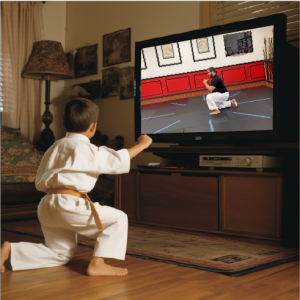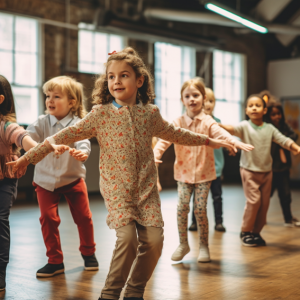 As parents and educators of children with autism, we know how imperative it is to develop strong communication and language skills. Autistic children often struggle with communication in varying ways, and it is obviously a large hurdle to overcome, especially regarding education. Unfortunately, traditional teaching methods can often fall short when it comes to addressing the unique needs and challenges of autistic children.
As parents and educators of children with autism, we know how imperative it is to develop strong communication and language skills. Autistic children often struggle with communication in varying ways, and it is obviously a large hurdle to overcome, especially regarding education. Unfortunately, traditional teaching methods can often fall short when it comes to addressing the unique needs and challenges of autistic children.
That’s where video modeling comes in and is one of the reasons why we have partnered with Achieve Martial Arts and their innovative learning program.
When we saw their learning module, we were taken aback at how perfectly their system fits into the learning needs of the children in our program.
Knowing that video modeling is an effective tool in learning for children across the spectrum, we felt that their program truly put this research into motion. Achieve’s design of learning progression in martial arts requires students to imitate, demonstrate, and repeat – all actions that have been shown to be successful in learning for autistic children.
In addition, they have built their program upon an independent learning format where children can progress through the steps at their own pace. We know that in traditional learning environments, this can be a huge challenge for autistic children. Achieve’s method supports and encourages skill acquisition through video modeling while challenging students to work towards their goals.
Let’s explore how video modeling can enhance communication and language skills in autistic children and demonstrate why it is so successful in environments like Achieve Martial Arts.
Imitation/Mimicry
“For children with autism, imitation allows them to look at others, observe interactions, and practice social skills by imitating others” (Karlen, 2019).
Video modeling has proven to be a powerful tool that uses visuals to teach and reinforce new skills. We have discovered a few different research studies that discuss how video modeling is a revolutionary discovery, especially when it involves children with special learning needs. We’ll post those links at the end of this blog for those of you that are interested.
While many autistic children struggle with learning how to communicate, we have found that video modeling provides a successful intermediary between learning a new skill and difficulty communicating during the process. Video modeling can provide a visual and auditory representation of language and communication, which helps autistic children to understand and imitate the sounds, gestures, and expressions associated with effective communication.
Knowing this, we felt it was vital to introduce the benefits of imitation and mimicry in a learning environment for autistic children. It’s easy to see that video modeling is a great way for children to associate social behaviors with consequences and has been proven through many research studies we’ve attached at the end of this blog. By watching others interact and imitating them, autistic children can experience things like their neurotypical counterparts. In many cases, by reinforcing positive behaviors, mimicry can provide autistic children with context and association through a behavior/consequence model.
 As autistic children learn how to communicate their needs through imitation, they will also learn the meaning in interacting with others and the motivation to repeat the behavior (Tomasello, Carpenter, Call, Behne, & Moll, 2005).
As autistic children learn how to communicate their needs through imitation, they will also learn the meaning in interacting with others and the motivation to repeat the behavior (Tomasello, Carpenter, Call, Behne, & Moll, 2005).
As we mentioned above, when positive behavior is echoed through imitation, children will be motivated to receive that same reaction. In addition, when they learn to imitate more gestures and echo words that are socially appropriate, they will learn what to do or say during situations to receive the favored reaction.
The more interactions they have with others, the higher the likelihood of forming meaningful friendships with others (Adreon & Durocher, 2007; White & Roberson-Nay, 2009).
Clear, Visual Representations
Video modeling provides a structured visual representation of a skill or behavior, making it easier for autistic children to understand and process the information. Autistic children often struggle with abstract concepts, but visual aids like videos can help them make sense of complex ideas in a concrete and tangible way.
Breaking down the movements into a granular level is one of the ways that Achieve’s martial arts program has streamlined the learning process through video modeling. Instructors demonstrate a series of movements, piece by piece. Once they’ve demonstrated each individual piece of the movement, they demonstrate it fluidly. This is an excellent way for autistic children to experience learning: since autism affects executive functioning, it is often difficult for a child to learn something new unless it is broken down to be less complicated.
Multi-step instructions can be difficult for those who suffer from executive dysfunction, and this video modeling program allows students to see each piece of the puzzle as they are learning. These smaller, more manageable pieces are a key to learning and retention for autistic children.
In addition, students can choose to repeat/revisit topics that they might have trouble learning or move ahead if they feel comfortable with their comprehension. The ability to choose their own learning pathway is another vital piece of the skill acquisition puzzle for autistic children. With our clear instructional videos, children can hold themselves to their specific level of comprehension without feeling that their success is dependent upon the rest of their classmates. They can move forward when they are comfortable and can build confidence while they are learning.
Video modeling is a revolutionary tool for education, especially within the realm of autism. It provides a space where students can absorb and retain information at their own pace while avoiding the often overwhelming setbacks from a traditional learning environment. Check out the studies below if you’d like to learn more about why this method of education works so well with autistic students:
If you haven’t already, learn more here about our partnership with Achieve Martial Arts and begin your child’s journey to self-discovery!

Research Studies: Video Modeling and Autism
- Evidence Based Practice Brief: Video Modeling
- Implementation and Effectiveness of Using Video Self-Modeling with Students with ASD
- Video Modeling: An Intervention for Autism
References
-
Adreon, D., & Durocher, J. S. (2007). Evaluating the college transition needs of individuals with high-functioning autism spectrum disorders. Intervention in School and Clinic, 42(5), 271-279. doi: 10.1177/10534512070420050201
-
Karlen, C. E. (2019). Joint attention and imitation: How early social skills relate to language, social behavior, and overall responsiveness to early intervention in children with autism (Doctoral thesis, Illinois State University, Illinois, United States of America). Retrieved from https://ir.library.illinoisstate.edu/cgi/viewcontent.cgi?article=2130&context=etd
-
Tomasello, M., Carpenter, M., Call, J., Behne, T., & Moll, H. (2005). Understanding and sharing intentions: The ontogeny and phylogeny of cultural cognition. Behavioral and Brain Sciences, 28, 675-691.

